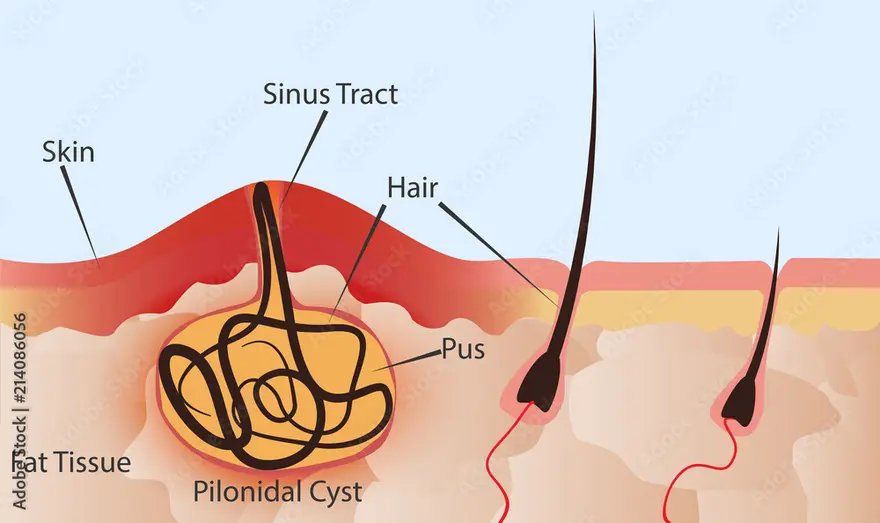
Pilonidal Sinus (Pilonidal Cyst): Causes, Symptoms, and Treatment
A Pilonidal Sinus (PNS) is a small tunnel or cyst that forms in the skin near the tailbone (coccyx), usually at the top of the buttocks. It often contains hair, debris, and skin particles and can become infected, leading to pain and pus formation.
Causes
The exact cause of a pilonidal sinus is not fully understood, but common factors include:
- Ingrown hair – Hair penetrating the skin can trigger an inflammatory reaction.
- Friction and pressure – Prolonged sitting, tight clothing, or excessive sweating can worsen the condition.
- Poor hygiene – Can contribute to bacterial infections.
- Obesity – Increases the risk due to extra skin folds and sweating.
- Genetic predisposition – Family history may play a role.
Symptoms
- Pain or swelling near the tailbone.
- Redness and tenderness in the affected area.
- Pus or blood drainage from the sinus opening.
- Foul-smelling discharge if infected.
- Fever in severe cases of infection.
Diagnosis
- Physical examination – Doctors check for swelling, pus, or tenderness.
- Ultrasound or MRI (rarely needed) – Used to assess deep infections.
Treatment
1. Home Care (For Mild Cases)
- Keep the area clean and dry.
- Shave or remove hair regularly to prevent recurrence.
- Warm compresses can help relieve pain and swelling.
- Avoid prolonged sitting and tight clothing.
2. Medical Treatment (For Infected or Severe Cases)
- Antibiotics – If there is an infection.
- Incision and Drainage (I&D) – The doctor makes a small cut to drain pus and relieve pain.
- Laser hair removal – Reduces hair growth to prevent recurrence.
3. Surgical Treatment (For Chronic or Recurrent Cases)
- Excision Surgery – The infected sinus is completely removed and left open to heal naturally (open method) or stitched closed (closed method).
- Flap Surgery – In severe cases, a skin flap is used to close the wound after removal of the sinus.
Prevention Tips
- Maintain good hygiene and wash the area regularly.
- Avoid prolonged sitting or excessive sweating.
- Keep the area hair-free by shaving or using hair removal creams.
- Wear loose-fitting clothes to reduce friction.
A pilonidal sinus can recur if not properly treated, so early care and prevention are essential. If symptoms worsen or recur, consult a doctor for surgical options.
Would you like advice on home remedies or surgical treatments?

